@CatacombSociety It's starting - will stay on as long as I can before teaching classes this p.m. @Ist_Svizzero #sharingcatacombs 

@CatacombSociety @Ist_Svizzero PhD candidate Caroline Bridel speaks about work on iconography and expression of identity at the grave. She defines "sharing" in space (proximity) and sharing of tomb, legally possible for all in #Rome, just law of propriety in terms of possession.
#SharingCatacombs
#SharingCatacombs

@CatacombSociety @Ist_Svizzero Bridel moves into topic of shared tomb design, architecture and objects, decorations (although we don't in fact know if the original developers of the "pagan" hypogeum at Vigna Randanini were in fact pagan - @archeoappia!). 
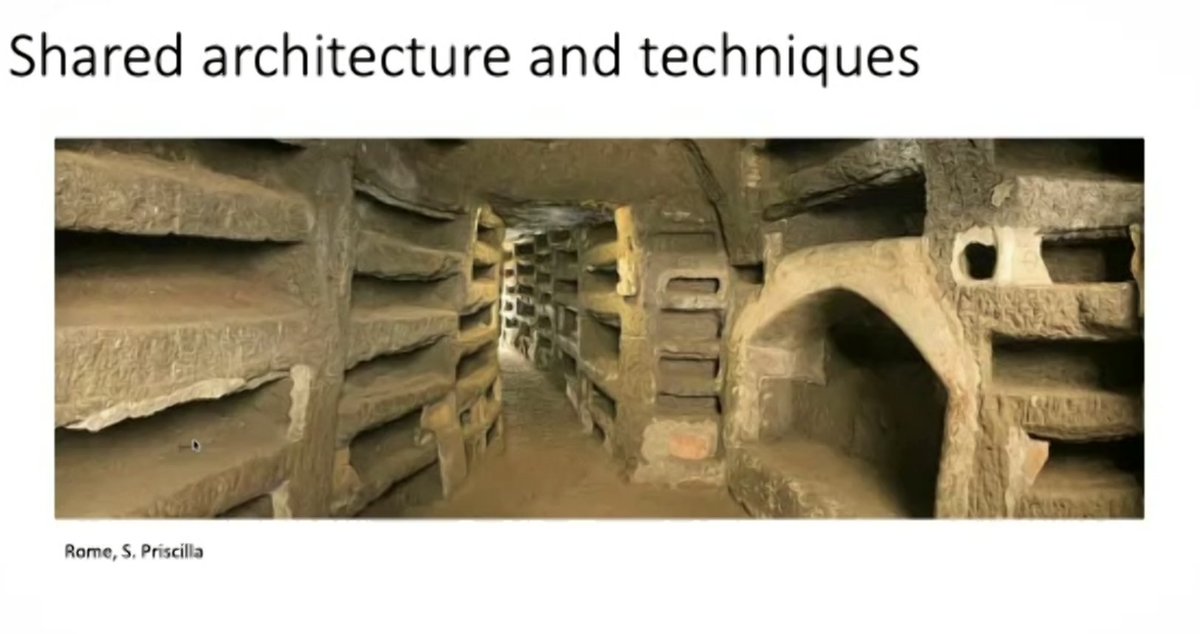
@CatacombSociety @Ist_Svizzero @archeoappia lots of sharing (Bridel) but "there is a possibility to express religious identity at the grave" - narrative from #Bible, strong faith signs (like menorah, Alpha-Omega, Christogram). DM mixed with #Christian symbols, though. #Rome has abundant evidence, but is it a special case? 

@CatacombSociety @Ist_Svizzero @archeoappia "traditional necropolis" - but "many surprises" according to #Vatican archaeologist Giandomenico Spinola, on his excavation of the via Triumphalis/Santa Rosa tombs, nearness of access point bearing on quality of tomb. Site of first stratigraphic excavation on Vatican grounds! 

@CatacombSociety @Ist_Svizzero @archeoappia only traces of many wood containers, imitations in marble of what was also created in organic matter, impressions in malta - wood would likely have been painted as well, also ashes in clay jars, but perhaps in organic container within pot. #SharingCatacombs 
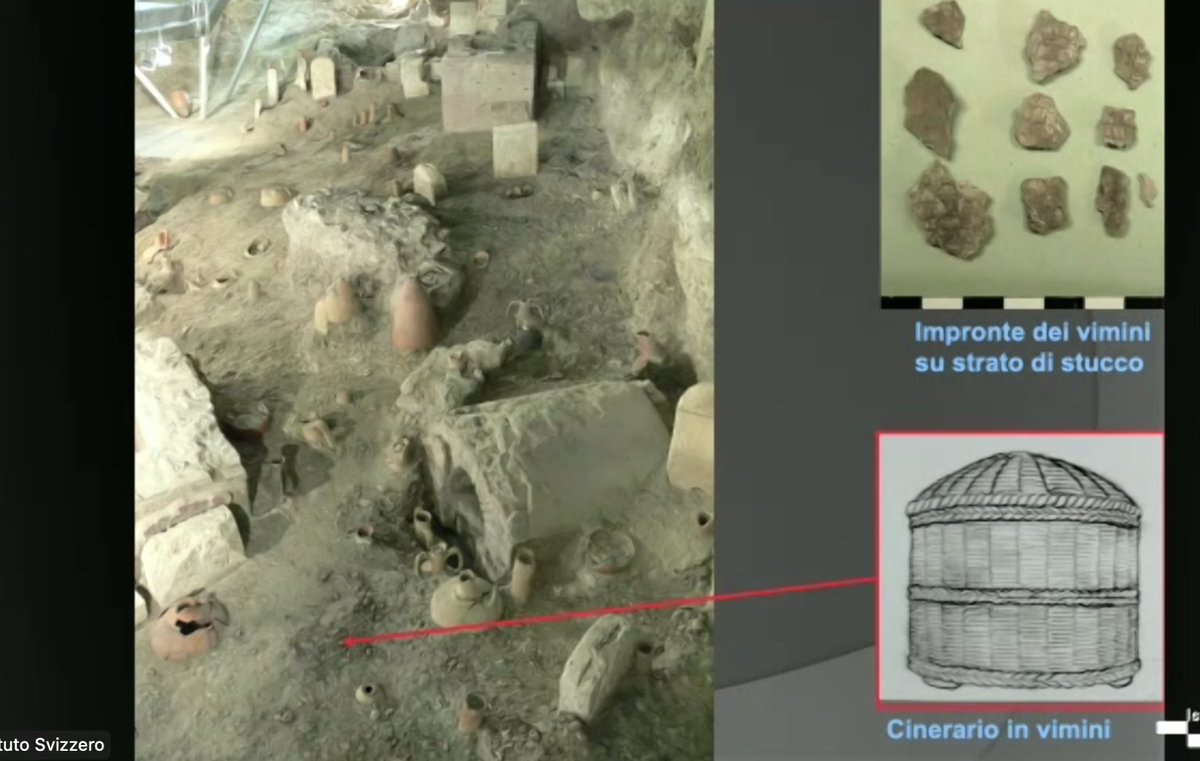
@CatacombSociety @Ist_Svizzero @archeoappia Neronian era tomb, then covered by landslide, intact. Tomb programmed, 6 cinerary urns, but anthropological study shows otherwise, some remains mixed, 2, 3, 4 people, can identify gender, age - in pavement, not 6 but 16! A post-mortem family reunion - religious? #SharingCatacombs 

@CatacombSociety @Ist_Svizzero @archeoappia then over 20 other corpses identified - family extended? The epigraphic evidence does not reveal how or why. Perhaps buried remains consecrated tomb. Maybe bones added, more defunct become manes, tomb became cumulative. #SharingCatacombs 

@CatacombSociety @Ist_Svizzero @archeoappia Evidence of passage to manes fascinating - "DM" comes to life, in a matter of speaking. Manifestations of how they were made to protect tomb, sepulchral space. #SharingCatacombs 

@CatacombSociety @Ist_Svizzero @archeoappia asbestos sheet to not mix bones inside container, element very costly, probably used in poor tomb illegally - taken from other space. Also breaking mirrors, coins, nails, "Salomon's knot" to block evil eye, magic tablets, #SharingCatacombs 

@CatacombSociety @Ist_Svizzero @archeoappia next is Giancarlo Lacerenza of @UniOrientale on epigraphic material in catacombs - especially linguistic elements, Hebrew and Aramaic. What conditions use of language in a tomb? Five cemeteries known in #Rome, chronology in tandem, second-to maybe sixth c. CE). #SharingCatacombs 

@CatacombSociety @Ist_Svizzero @archeoappia @UniOrientale Above all in 4th c. CE an "explosion" of #Jewish motifs in Roman tombs (also in Sicily, Venosa, Sardinia, etc.), also to mark out area, not just single tomb. A "declaration". But #Rome has bulk of epitaphs! #SharingCatacombs 

@CatacombSociety @Ist_Svizzero @archeoappia @UniOrientale Classy of Lacerenza to mention the many opportunities to visit Catacombs of #Jews in #Rome with guides :-) Lacerenza also points out rich epigraphic collections in museums, especially #Vatican, although modern display can "disorient" for design. #SharingCatacombs 

@CatacombSociety @Ist_Svizzero @archeoappia @UniOrientale Greek used in Rome - because they spoke Greek? Liturgical language? We have only indirect evidence of vitality of "Jewish Greek" at time. Several mentions of "assemblies" synagogues, including one of "Hebrews", perhaps linguistic reference #SharingCatacombs @Ist_Svizzero 
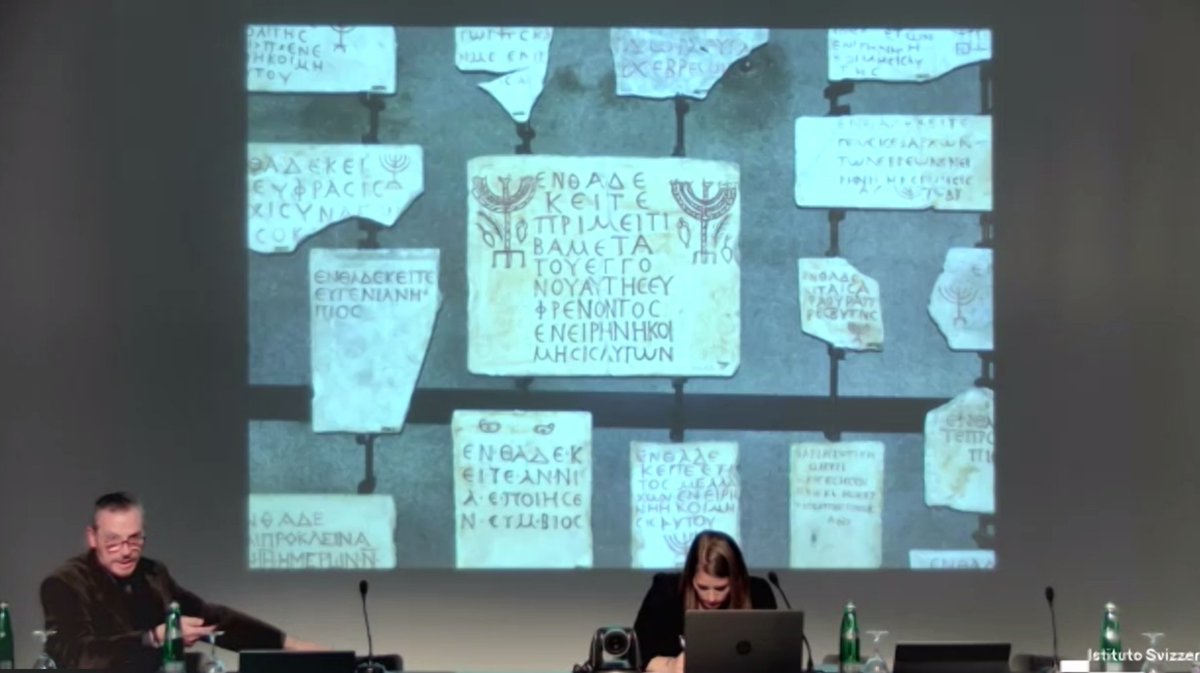
@CatacombSociety @Ist_Svizzero @archeoappia @UniOrientale As Lacerenza points out, even in North Africa and Israel, Greek prevails as epigraphic language for Jews in late Roman Era, at least through third c. CE. And in cultic association, what are titles? Do some motifs refer to roles of these people as mentioned on tombs? 

@CatacombSociety @Ist_Svizzero @archeoappia @UniOrientale Lacerenza sees "#Jewish" identity in #Rome expressed on the whole by non-textual motifs ("nude and crude"). Menorah marks & locates a Jew, even into #MiddleAges. "Certainty" even to the illiterate. Hebrew language? Marginal, often a "symbol" not written correctly. @Ist_Svizzero 

@CatacombSociety @Ist_Svizzero @archeoappia @UniOrientale Reiterate - "Shalom" essentially used as motif. Even on fancy examples, written in non-standard form. Even if representing linguistic dynamics, perhaps invocatory. Not because Jews were in diaspora, also Beth Shearim Hebrew same predominance of Greek, mix of cultural expressions 

@CatacombSociety @Ist_Svizzero @archeoappia @UniOrientale Is this even Hebrew?? broken up by line of Greek. Perhaps Shalom in reference to Psalms, also the Greek phrase "in peace his/her sleep". In same place as Hebrew b'shalom. Almost never whole inscription in Hebrew/Aramaic. 
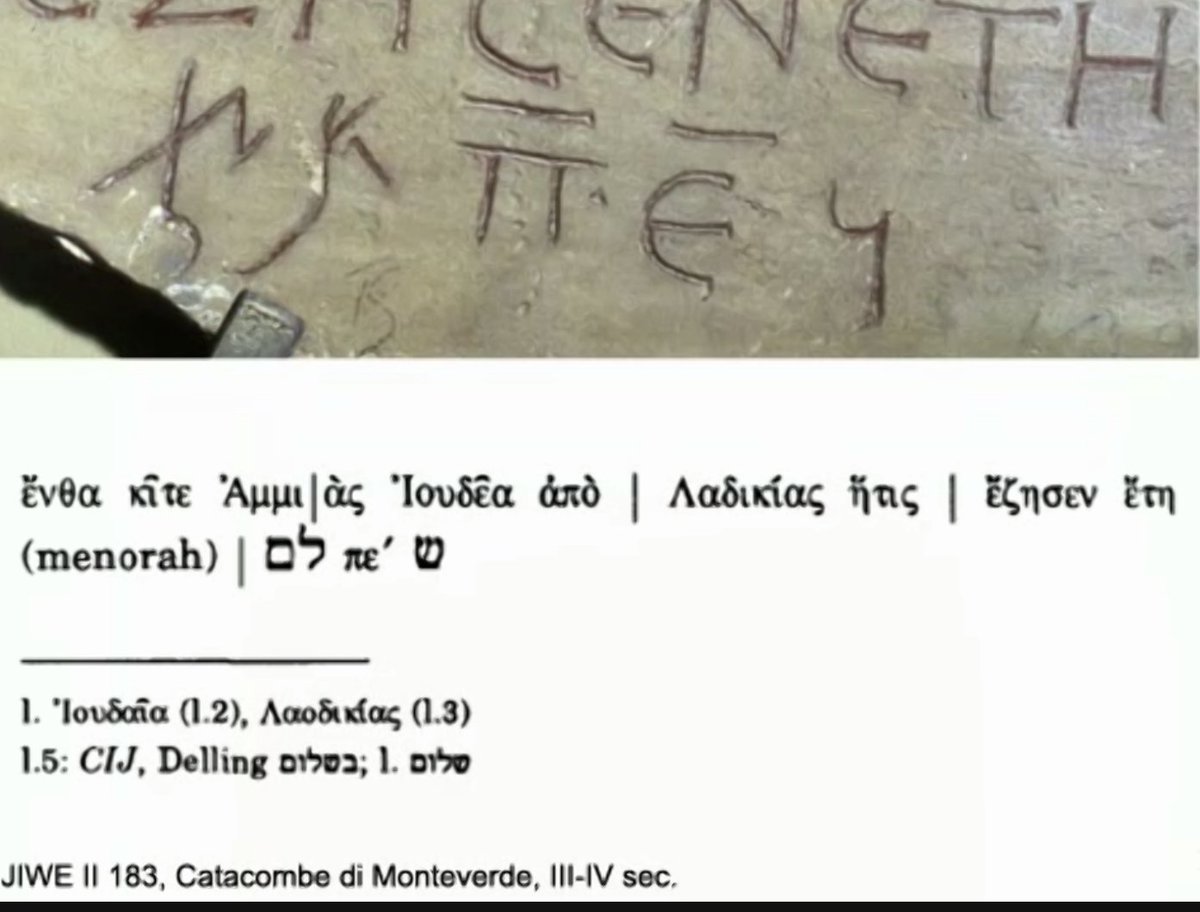
@CatacombSociety @Ist_Svizzero @archeoappia @UniOrientale "Text no longer a text but a motif" - Greek text, Latin text, and "shalom" repeated in Hebrew - written rather well, in fact! - inscription has Hebrew "frame", other examples in 4th-6th, also JIWE 2, n. 550. "Writing is no longer writing but joins other symbols". 

@CatacombSociety @Ist_Svizzero @archeoappia @UniOrientale New Hebrew inscription on the block - from Villa Torlonia - someone, maybe visitor to #Rome? - knew Hebrew, could write it, we might be seeing that here. Conclusion: Hebrew seems to have has symbolic use in tomb setting in Rome. #SharingCatacombs 

@CatacombSociety @Ist_Svizzero @archeoappia @UniOrientale Learning that Norbert Zimmerman is also conducting studies of Randanini and Cimarra catacombs - (I "rediscovered" the latter :-),
How do paintings reflect how space around tombs were used?
#SharingCatacombs
How do paintings reflect how space around tombs were used?
#SharingCatacombs

@CatacombSociety @Ist_Svizzero @archeoappia @UniOrientale Zimmermann notes not everybody was using catacombs - lots of activity in sepulchral culture, ca. 200, "#Christian" burials appear. Not so clear why (yes, there were Christians before then, but archaeologically, catacombs preserve these traces. Why catacombs? (Poor) tombs in bulk? 

@CatacombSociety @Ist_Svizzero @archeoappia @UniOrientale Chronological breakdown of paintings, mostly next to entrances, privileged sites, But we don't see grave gardens, mausolea, other parts sub divo. We don't see what inspired what we now see. Catacombs important, but major aspect is not seen. #SharingCatacombs 
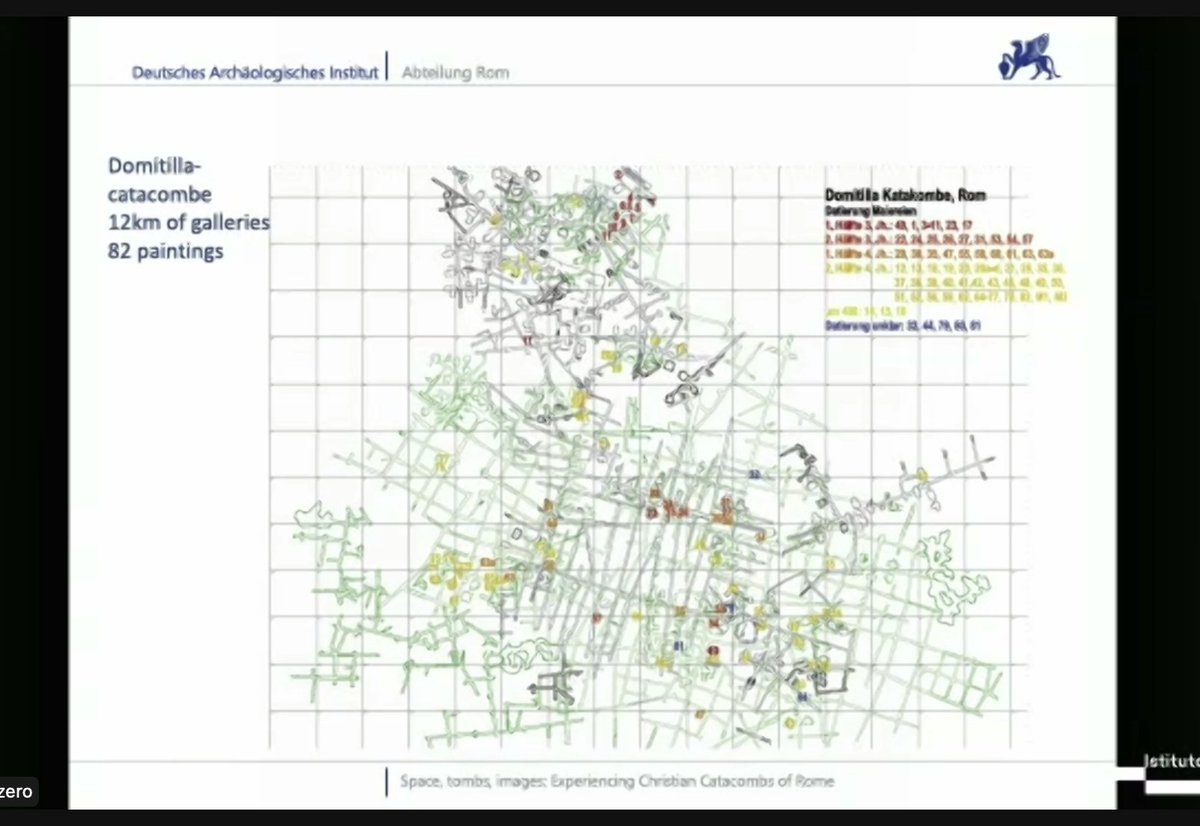
@CatacombSociety @Ist_Svizzero @archeoappia @UniOrientale "To produce images, (the Christians) were already culturally Roman in behavior." Painting private duty of the owner, not officially ordered - we must see it as private contract, not controlled by church officials. Every painting done exclusively, no double dipping on content. 

@CatacombSociety @Ist_Svizzero @archeoappia @UniOrientale So why a development #Christian art at all? 230-260, in Catacomb of Callisto, developing of this iconography. 2-3 phases in Area 1. #Biblical scenes, before they were standardized in 4th c., also on sarcophagi. Abraham, Lazarus, painter is still figuring out the image in mid-3d c 
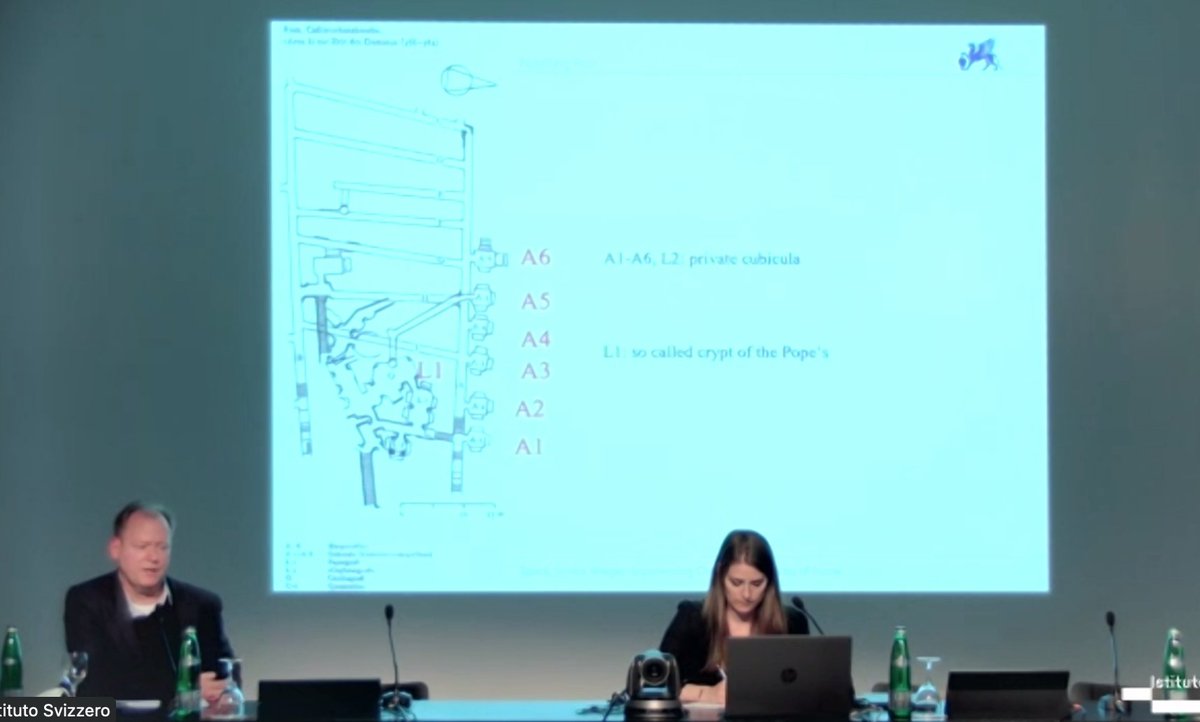
@CatacombSociety @Ist_Svizzero @archeoappia @UniOrientale Zimmerman points out most represented after a point in Christian imagery around grave is pictures of deceased/representations of deceased. Orans, banquet feasters, portraits in paradise, portrait may even enter #Biblical scenes. #SharingCatacombs 

@CatacombSociety @Ist_Svizzero @archeoappia @UniOrientale interesting Zimmermann sees this painted loculus as a sort of take on a sarcophagus, scenes don't necessarily have order (?) Central scene is Lazarus, only one from NT. All kind of prayer with images of salvation around tomb. 

@CatacombSociety @Ist_Svizzero @archeoappia @UniOrientale Chamber of the Mensores in Catacombs of Domitilla - can't wait for complete publication of these diagrams and readings! Organization of art reflects to a degree tomb distribution. Projection of number of tombs in room (but many more later added). #SharingCatacombs 

@CatacombSociety @Ist_Svizzero @archeoappia @UniOrientale Zimmermann discusses also different catacomb designs, distinct project objectives for different sites. Certain order, thought out in certain way, rational use of programmed space, some never actually used, with wall painting laid around. #SharingCatacombs 

@CatacombSociety @Ist_Svizzero @archeoappia @UniOrientale I asked a question about the ways in which individuals may have chosen certain motifs to connect themselves to community assemblies - not just individual statements but the collective. I still think some catacomb art was "copy" art from real places! #SharingCatacombs 

• • •
Missing some Tweet in this thread? You can try to
force a refresh









